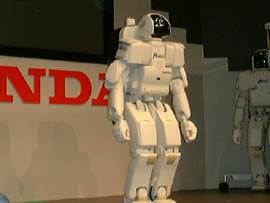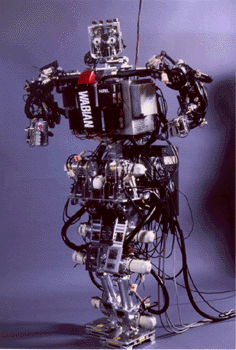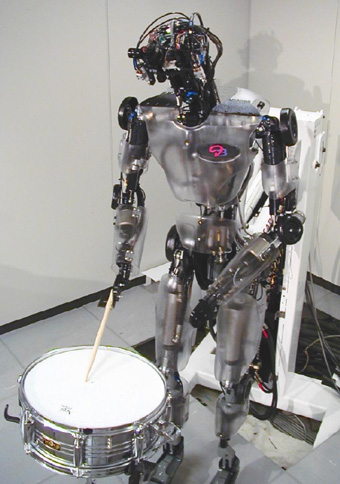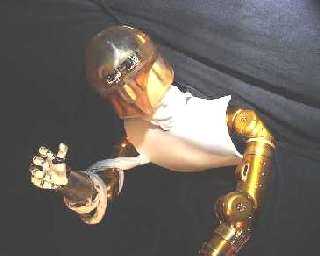CSCI 599 - Perceiving and Controlling Humanoid Behavior
CSCI 599
Perceiving and Controlling Humanoid Behavior
|
Taught: Spring 2001
If you are enrolled in this class, please check this page regularly to
find new or updated information.
Instructor
Office : SAL 228
Phone : (213) 740-4520
Email : mataric@cs.usc.edu
WWW : http://robotics.usc.edu/~maja
Office
Hours : by appointment; send email or talk w/ prof. after class
Time and place
Thursdays, 2pm-4:50pm, location: SAL 322.




Course description
This is a seminar-style hands-on survey course. We will read
papers covering two related topics: 1) control of humanoid robots and
simulations, and 2) perception and understanding of human and humanoid
(i.e., simulated and robotic) behavior.
This course is motivated by two currently surging areas of research:
humanoid robot and character control (relevant to both robotics and
graphics/animation), and perception and understanding of human and
humanoid behavior (relevant to machine vision, robotics, and AI).
We are currently at the edge of a new frontier in robotics: the
technology has finally reached a stage where practical humanoid robots
can be built, as has been manifested by the Honda P3, the Sarcos
full-body robot, the MIT Cog (torso) robot, NASA's Robonaut, and many
others in Japan. As such highly complex system are becoming
available, how to control them becomes a major open research issue.
The challenge of humanoid control puts to the test classical notions
of robotics, as it demands scalability, robustness, and flexibility.
Approximately half of the reading material in thic course will deal
with this topic area.
Perceiving and understanding natural, unconstrained behavior of humans
is a complex problem, not only from the perspective of machine
vision, but from higher-level reasoning as well. The goal of that
area of research is to be able to understand the observed activity,
whether it be the movement of an individual (e.g., Mary is
performing a tennis serve), the interaction of a small group (e.g.,
one person is presenting, the rest are listening; there is a small
gathering forming), or the general behavior of a crowd (e.g., there is
a rally going on, the crowd is disbanding, etc.). Methods for
addressing these complex issues encompass the range from low-level
sensory processing and sensor fusion, to statistical models of
movement, to high-level models of intentionality. Approximately half
of the reading material in this course will be devoted to this topic
area.
This class consists of reading, presenting, discussing, and crituquing
papers. It also involves weekly short (one-page) reports on the
covered papers, and a final project, presented it to the class, and
accompanied by a final report. Presentations, critiques, reports, and
projects are all described in more detail below.
No textbook is used in this course; instead, we will read original
papers from the field, and discuss and critique them in class.
Students will take turns presenting and debating the readings, and
will turn in one-page summaries of the readings each week.
Prerequisites Undergraduate AI (e.g., CSCI 460) or graduate
AI (CSCI 561a) or Introduction
to Robotics (CSCI 445) or CSCI 584
or permission of instructor.
Reading List
Note: the following is a list of readings from which the course papers
will be drawn. The list below is not necessarily complete, but not
nearly all of the papers on the list will be read in the course. In
Spring 2001, two papers will be read per week, totalling 26 papers for
the semester.
Perception of human/oid motion
Visual
perception of biological motion and a model for its analysis by
G. Johansson (1973), Perception and Psychophysics 14, 201-211
Subconfigurations
of the human form in the perception of biological motion by J. Pinto,
M. Shiffrar, (1999), Acta Psychologica 102, 293-318
Efficient
Matching of Pictorial Structures by Pedro F. Felzenszwalb,
Daniel P. Huttenlocher, (2000), CVPR 2000
Towards detection of human motion by Y. Song, X. Feng,
P. Perona, (2000). [alternate
link]
Finding People
by Sampling by Sergey Ioffe and David Forsyth, (1999), International
Conference on Computer Vision
Articulated Body Motion Capture by Annealed Particle Filtering by
J. Deutscher, A. Blake, I. Reid, (2000)
Automatic
Joint Parameter Estimation from Magnetic Motion Capture Data by
J. O'Brien, B. Bodenheimer, G. Brostow, J. Hodgins
Real-time
closed-world tracking by S. Intille, J. Davis, A. Bobick, (1996)
M.I.T. Media Laboratory Perceptual Computing Section Technical Report
No. 403
Stochastic tracking of 3D human figures using 2D image motion by
H. Sidenbladh, M. Black, D. Fleet, (2000), European Conference on Computer
Vision, Dublin, Ireland
A
cluster-based statistical model for object detection by T. Rikert,
M. Jones, P. Viola, (1999), International conference on computer
vision
Complex
feature recognition: A Bayesian Approach for learning to recognize
objects by P. Viola, (1996), M.I.T. Artificial intelligence
laboratory
Exploiting
human actions and object context for recognition tasks by
D. Moore, I. Essa, M. Hayes, (1999), G.I.T, Graphics, Visualization
and Usability center, Technical report# GIT-GVU-99-11. [
alternative link]
Representation
and visual recognition of complex, multi-agent actions using belief
networks by S. Intille, A. Bobick, (1998), M.I.T. Media Laboratory
Perceptual Computing Section Technical Report No. 454
A
framework for recognizing multi-agent action from visual evidence
by S. Intille, A. Bobick, (1999), M.I.T. Media Laboratory Perceptual
Computing Section Technical Report No. 489
The
representation and recognition of action using temporal templates
by J. Davis, A. Bobick, (1997), M.I.T. Media Laboratory Perceptual
Computing Section Technical Report No. 402
Categorical
representation and recognition of oscillatory motion patterns by
J. Davis, A. Bobick, W. Richards, (2000), Pro. Comp. Vis. and
Pat. Rec. June 2000
Automatic
Generation of Kinematic Models for the Conversion of Human Motion
Capture Data into Humanoid Robot Motion, A. Ude; C. Man; M. Riley;
C. G. Atkeson , Proceedings, Humanoids 2000. [ technical
report version]
Coupled
hidden markov models for complex action recognition by Matthew
Brand and Nuria Oliver and Alex Pentland (1996), Proceeding, CVPR
1997
Monocular
perception of Biological motion-detection and Labeling by Y. Song
and L. Goncalves and E. Bernardo and P. Perona (1999), ICCV 99
Monocular
perception of biological motion-clutter and partial occlusion by
Y. Song and L. Goncalves and P. Perona (2000), Proceeding ECCV
2000
Eigenfaces
for recognition by M. Turk and A. Pentland (1991), MIT
Pfinder:
Real-time tracking of the human body by C. Wren and
A. Azarbayejani and T. Darrel and A. Pentland (1996), WFGR 96
A 3-D model-based tracking of humans in action: a multi-view
approach by D. Gavrila and L. Davis (1996), CVPR96
Real-time human
motion analysis by image skeletonization, H. Fujiyoshi and
A. Lipton (CMU). [alternate
link]
Control of human/oid motion
Quantitative examinations of internal representations for Arm
Trajectory Planning: Minimum commanded torqe change model by E. Nakano
and H. Imamizu and R. Osu and Y. Uno and H. Gomi and T. Yoshioka and
M. Kawato (1999), The American Physiological Society 99
Hierachical multiple paired forward-inverse models for generation and
perception of motor sequences, by M. Haruno and K. Doya and
D. Wolpert and M. Kawato (2000)
Multiple paired forward-inverse models for sensorimotor learning
and control, by M. Haruno and D. Wolpert and M. Kawato (2000)
Making Complex Articulated Agents Dance: an analysis of control
methods drawn from robotics, animation, and biology, by Maja J
Mataric, Victor B. Zordan, and Matthew M. Williamson, Autonomous
Agents and Multi-Agent Systems, 2(1), Mar 1999, 23-44.
Style
Machines by Matthew Brand and Aaron Hertzmann (2000), MERL,
TR-2000-14
Impedance
Control as a Merging Mechanism for a Behavior-Based Architecture
by G.Beccari and S. Stramigioli, Proceedings, IEEE ICRA, 1998.
Linear
combination of primitives in vertebrate motor control by
F. Mussa-Ivaldi, S. Giszter, and E. Bizzi, PNAS, Vol 91, Aug 1994.
Impedance Control: An Approach to Manipulation, N. Hogan,
Journal of Dynamic Systems, Measurement, and Control, Vol 107, March
1985.
The coordination of arm movements; an experimentally confirmed
mathematical model, T. Flash and N. Hogan, Journal of Neuroscience,
Vol 7, 1985.
A
neurobiological perspective on humanoid robot design by
S. Giszter, K. Moxon, I. Rybak, and J. Chapin, IEEE Intelligent
Systems, July/Aug 2000.
Aminating
human athletics, J. Hodgins, W. Wooten, D. Brogan, and J. O'Brian,
SIGGRAPH 1995.
Computation aspects of motor control and motor learning,
M. Jordan, Handbook of Perception and Action: Motor Skills, H. Huer
and S. Keele, eds, 1993.
Programmable
Pattern Generators, S. Schaal and D. Sternad, Proceedings, 3rd
Int. Conference on Coputational Intelligence in Neuroscience,
1998.
A computational theory for movement pattern recognition based on
optimal movement pattern generation, Y. Wada, Y. Koie, E. Bateson,
and M., Biological Cybernetics, Vol 73, 1995.
Rhythmic
robot control using oscillators, M. Williamsn, Proceedings IROS
1998.
Tracking
and Modifying Upper-body human motion data with dynamic simulation
by V. Zordan, J. Hodgins
On the Emulation of Natural Movements by Humanoid Robots,
M. J. E. Richardson; T. Flash, Proceedings, Humanoids 2000.
Spring 2001 Syllabus
Note: please bring the readings to class on the assigned day
Jan 11 :
Introduction to the course, reading assignments.
Jan 18 :
Articulated
Body Motion Capture by Annealed Particle Filtering by
J. Deutscher, A. Blake, I. Reid, (2000); Presenter: Chad Jenkins.
Automatic
Joint Parameter Estimation from Magnetic Motion Capture Data by
J. O'Brien, B. Bodenheimer, G. Brostow, J. Hodgins. Presenter: Ajo Fod.
Jan 25 :
Visual
perception of biological motion and a model for its analysis by
G. Johansson (1973), Perception and Psychophysics 14, 201-211. [video]
Presenter: Michael Nili.
Making Complex Articulated Agents Dance: an analysis of control
methods drawn from robotics, animation, and biology, by Maja J
Mataric, Victor B. Zordan, and Matthew M. Williamson, Autonomous
Agents and Multi-Agent Systems, 2(1), Mar 1999, 23-44. [more info and
videos] Presenter: Brian Gerkey.
Feb 1 :
Linear
combination of primitives in vertebrate motor control by
F. Mussa-Ivaldi, S. Giszter, and E. Bizzi, PNAS, Vol 91, Aug
1994. Presenter: Tin Nguyen.
A
neurobiological perspective on humanoid robot design by
S. Giszter, K. Moxon, I. Rybak, and J. Chapin, IEEE Intelligent
Systems, July/Aug 2000. Presenter: Daniel Arbuckle.
Feb 8 :
Exploiting
human actions and object context for recognition tasks by
D. Moore, I. Essa, M. Hayes, (1999), G.I.T, Graphics, Visualization
and Usability center, Technical report# GIT-GVU-99-11. [
alternative link]. Presenter: Monica Nicolescu.
Impedance
Control as a Merging Mechanism for a Behavior-Based Architecture
by G.Beccari and S. Stramigioli, Proceedings, IEEE ICRA,
1998. Presenter: Chad Jenkins.
Feb 15 :
-->Background reading material on HMMs:
An HMM tutorial; another HMM tutorial.
Coupled
hidden markov models for complex action recognition by Matthew
Brand and Nuria Oliver and Alex Pentland (1996), Proceeding, CVPR
1997. Presenter: Chad Jenkins.
Style
Machines by Matthew Brand and Aaron Hertzmann (2000), MERL,
TR-2000-14. Presenter: Ajo Fod.
Feb 22 :
Subconfigurations
of the human form in the perception of biological motion by
J. Pinto, M. Shiffrar, (1999), Acta Psychologica 102,
293-318. Presenter: Michael Nili.
A 3-D model-based tracking of humans in action: a multi-view
approach by D. Gavrila and L. Davis (1996), CVPR96. Presenter:
Tin Nguyen.
Mar 1 :
Representation
and visual recognition of complex, multi-agent actions using belief
networks by S. Intille, A. Bobick, (1998), M.I.T. Media Laboratory
Perceptual Computing Section Technical Report No. 454. Presenter:
Michel Nili.
Towards
detection of human motion by Y. Song, X. Feng, P. Perona,
(2000). [alternate
link] Presenter: Daniel Arbuckle.
Mar 8 : Project proposals due in class.
The
representation and recognition of action using temporal templates
by J. Davis, A. Bobick, (1997), M.I.T. Media Laboratory Perceptual
Computing Section Technical Report No. 402. Presenter: Monica
Nicolescu.
Real-time human
motion analysis by image skeletonization, H. Fujiyoshi and
A. Lipton (CMU). [alternate
link]. Presenter: Brian Gerkey.
Mar 15 : No class, Spring Break.
Mar 22 : no class, out of town, readings and
presentations are added to classes below
Mar 29 :
Computation aspects of motor control and motor learning,
M. Jordan, Handbook of Perception and Action: Motor Skills, H. Huer
and S. Keele, eds, 1993. Presenter: Ajo Fod.
The coordination of arm movements; an experimentally confirmed
mathematical model, T. Flash and N. Hogan, Journal of Neuroscience,
Vol 7, 1985. Presenter: Michael Nili.
On the Emulation of Natural Movements by Humanoid Robots,
M. J. E. Richardson; T. Flash, Proceedings, Humanoids 2000. Presenter:
Monica Nicolescu.
Apr 5 :
Categorical
representation and recognition of oscillatory motion patterns by
J. Davis, A. Bobick, W. Richards, (2000), Pro. Comp. Vis. and
Pat. Rec. June 2000. Presenter: Amit Ramesh.
Programmable
Pattern Generators, S. Schaal and D. Sternad, Proceedings, 3rd
Int. Conference on Coputational Intelligence in Neuroscience,
1998. Presenter: Amit Ramesh.
Apr 12 :
Rhythmic
robot control using oscillators, M. Williamsn, Proceedings IROS
1998. Presenter: Tin Nguyen.
Improved Tracking of Multiple Humans with Trajectory Prediction and
Occlusion Modeling, by R. Rosales and S. Scaroff
(1998). Presenter: Michael Nili and Tin Nguyen.
Apr 19 : no class, out of town, readings and
presentations are added to next class, below
Apr 26 :
Automatic
Generation of Kinematic Models for the Conversion of Human Motion
Capture Data into Humanoid Robot Motion, A. Ude; C. Man; M. Riley;
C. G. Atkeson , Proceedings, Humanoids 2000. [ technical
report version]. Presenter: Daniel Arbuckle.
Tracking
and Modifying Upper-body human motion data with dynamic simulation
by V. Zordan, J. Hodgins. Presenter: Brian Gerkey.
Multiple paired forward and inverse models for motor control, by
M. Haruno and K. Doya and D. Wolpert and M. Kawato (2000). Presenter:
Amit Ramesh.
May 8 : Final: project presentations, 2-3pm.
May 10 : Final: project presentations, 2-5pm.
Presentations, Critique, and Weekly Reports
The student presenting a paper in a given class should prepare a clear
30-minute presentation. This presentation should assume that the
audience has read the paper, and not spend more than about 5 minutes
summarizing it. Most of the presentation should be spent on
discussing the paper, its strengths, weaknesses, any points needing
clarification, and addressing any questions the other students may
have.
For information on how to present a paper, look here
and for even more detail, look here.
In this course, formal presentations are not expected. However, you
are expectd to prepare at least an organized board presentation, or
for involved papers, overheads; projected presentations are optional
but may be more clear and manageable for some papers. Please work with
Prof. Mataric's assistant, Kusum Shori (kusum@pollux.usc.edu) ahead of
time to arrange for the necessary equipment you will need to present
your paper.
For each paper being covered on a given day (whether you are
presenting it or not), you will bring to class a one-page report,
consisting of two parts: 1) a paragraph or two summarizing the paper
(copies of the abstract and/or intro and/or conclusions will not do!);
2) two or so paragraphs critiquing the paper. The critique should
take the form of addressing the strengths and weaknesses of the paper,
comparing it briefly to other work, if relevant, etc.
In summary, for each class, you should bring: 1) the two papers being
discussed, 2) two reports, one for each of the papers, 3) a
presentation, if you are presenting one of the papers, 4) a great
enthusiasm for discussing the two papers. :)
Course Project
The principles learned in class will be applied in individual
programming projects, either employing humanoid perception or control.
For the former, the students are encouraged to either seek out on-line
vision databasees, or obtain input data in the lab (talk to the
instructor early). For the later, a simulation testbed will be made
available (again, talk to the instructor early). Project proposals
describing specific goals will be due in the middle of the semester
(see syllabus). A detailed
final paper is a required part of the final project; it will be
due on the last day of
presentations, and it will be made available to all students in
the class, preferrably via a Web pointer.
Helful information for preparing your project presentation can be
found
here, and for preparing your final paper here.
Grading
Performance in the class will be based on participation in class
discussions, presentations of the papers, weekly reports on the
readings, and a final project (with an associated paper and
demonstration). Regular attendance and participation is required; if
you need to miss a class, please speak to Prof. Mataric ahead of
time.
Specifically, final course grades will consist of:
20% reading reports
20% in-class discussion participation
30% in-class paper presentations
30% final project implementation and final paper
Related Web Sites and Readings
A recent article on the new
Sony humanoid robot.
Sarcos.
The ATR DB humanoid.
The Wasseda University Wabian
humanoid.
The MIT Cog humanoid torso.
The NASA Robonaut.
The first IEEE/RAS Humanoids
Conference 2000.
(These are mostly simulations of mobile
robots. Talk to Prof. Mataric about humanoid simulation if needed for
the course project.)
U.S.C. Computer Science Department
U.S.C.
Back to top


